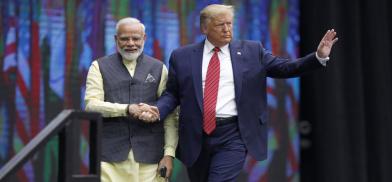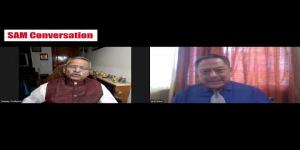Trump visit may be high on optics, low on substance
The visit will be high on optics and low on substance as both Trump and Indian Prime Minister Narendra Modi seek relief from domestic pressures and revalidation before their citizens, writes Arul Louis for South Asia Monitor

Donald Trump returns to India this weekend as US president, looking forward to a cinematic spectacle of adulating millions to stake his claim to international statesmanship following his acquittal by the Senate and the misguided standoff with Iran. The visit will be high on optics and low on substance as both Trump and Indian Prime Minister Narendra Modi seek relief from domestic pressures and revalidation before their citizens.
Trump visited India in 2014 as a businessman. His company – from which he is dissociated now as president – has four real estate projects in Gurugram, Mumbai, Kolkata and Pune.
Modi and Trump are masters of the art of showmanship and it will be a symbiotic relationship. For Trump's supporters, the Ahmedabad spectacle will be a panorama - if they get beyond the filter of the US media – of him being hailed by hundreds of thousands in a distant, friendly land. Crowds perhaps bigger than he draws in the US. For Modi, the gushing praise from the leader of the world's most powerful nation will boost his image among the non-ideological segment of the citizenry.
Placing themselves in a sterile bubble, Modi is taking him for the 'Namaste Trump'mega-event to Ahmedabad in his home state of Gujarat which has not seen the kind of agitation roiling the rest of India against the citizenship law amendment for refugees from religious persecution.
Trump has indicated that he did not expect the much-awaited trade deal to be signed, but left room for a mini-agreement of some sort – if he can claim a victory before his “Make America Great Again” supporters. Any other announcements about bilateral relations during the trip would only be presidential-prime ministerial embellishments of what has happened.
Much of the substantive work for building up strategic relations in the diplomacy and military spheres have been done in the 2+2 ministerial dialogue of defence and foreign affairs cabinet officials of the two countries, most recently in December.
While a large segment of the media in India can be expected to be swept up in the Trump-Modi wave, the elites and the ideological segments of the media will remain harsh critics. How the visit will play out in the US media is another matter. The US mainstream media is equally hostile to both Trump and Modi and will be sure to rain on the Trump-Modi parade. Given that India is an open society, there will be enough anti-Modi-Trump protests to report on and the poverty metres away from the regal routes (being hidden by walls). And the absence of a trade deal will be another issue for them to pick on.
For Trump, who has an obsession with sizes and superlatives, the question is would the crowds match his expectations? He told reporters, “Just spoke with Prime Minister Modi, and he said we will have millions and millions of people. … He thinks we will have 5 to 7 million people just from the airport to the new stadium.”
That would seem a difficult number to muster, given that current high-end estimates of Ahmedabad's population is only 6 million. The shortest route from the airport to the stadium is about 11 kilometres. Even if the crowd was standing five deep on either side, the crowd would be between 200,000 and 300,000 depending on how closely they are packed. If the crowd is ten deep it would still be only 400,000 to 600,000. It would require a very circuitous route to get 5 million people.
Perhaps, Modi said 5 to 7 lakhs – the Indian unit of 100,000s. A disappointment on the crowd front could dog Trump – and Modi – after the trip.
Trump's first controversy after his swearing-in was about crowd size – his administration said it was the largest ever for a presidential inauguration, which was disputed by the media and others. The administration then produced doctored pictures to buttress the claim.
As symbolisms go, Trump and Modi together can make a statement before the Asian neighbourhood, especially with an eye China, about the relations between the two countries. Trump has turned the US strategic focus towards Asia where China is emerging as the dominant power, renaming it Indo-Pacific to include India in what US officials say is a zone “bookended by two democracies,” India and the US.
Relations between the two countries are at an even keel, having been built up since the time of George W Bush, who initiated the nuclear cooperation agreement with India overcoming domestic opposition, and nurtured by Barack Obama. Under Trump it is closer at the strategic level, the trade disputes notwithstanding.
India has given up its doctrinaire non-alignment policy and the US, with the end of the Cold War, has become more flexible, away from the Cold War outlook that marked Richard Nixon, for example. But differences do exist between the two countries on some issues. India buying the ‘Triumf’ S400 missile defence system from Russia can put it under US sanctions. The Trump administration does not want India to buy the Chinese Huawei 5G telecommunication system.
And the US and India differ on Iran, although Washington has exempted its Chabahar port project in Iran from sanctions, as it is a link to land-locked Afghanistan.
Even though these issues may figure in private talks, they are unlikely to be aired in public – unless there are pointed questions at media encounters.
Trump, if he sticks to script as he did at the 'Howdy Modi' event in Houston, would stay away from Kashmir and other domestic issues. The administration has been very measured in statements about Kashmir and on human rights issues, pointing out the judicial processes in India and the public debates.
Modi is taking a risk in inviting Trump to India a little over eight months from the presidential election for a grand show meant to help him boost his image.
Many Democrats are critical of India – a big change from the Cold War era, when Republicans were more likely to be hostile. The opposition to India is coming from the ascendant left-wing of Democratic Party represented by Senator Bernie Sanders, the current front-runner for the party's nomination to run against Trump in November.
Sanders tilts towards Pakistan. In a recent party debate, he gave priority to working with Pakistan on climate change over India, even though India is the world's the third-largest emitter of greenhouse gases accounting for nearly 7% of the world's output, while Pakistan's share is only 0.52% and would hardly make a dent in the problem.
The emerging contender, Mike Bloomberg, favours China. In this week's party debate he tried to divert criticism of China by claiming that India was a bigger problem for climate change, even though China is the world's top emitter of greenhouse gases.
With the November elections in mind, Trump will also be looking to see if he can win over the Indian-American community, 71% of whose members have supported the Democratic Party. In 2016, he became the first presidential candidate to make an outreach to Hindus, although it is common practice in US politics to appeal to religion during elections.
(The writer is a New York-based journalist and Non-Resident Senior Fellow of the Society for Policy Studies-SPS)














Post a Comment